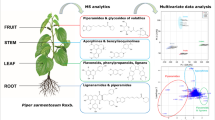Abstract
Heliopsis longipes (Asteraceae) is a plant whose roots are commonly used in Mexican cuisine as a substitute for hot pepper. This plant is also used in traditional medicine for its therapeutical properties. Previous reports detected the presence of affinin—an alkamide with analgesic properties—in extracts of H. longipes. Here, we describe the development of a high-performance liquid chromatography-UV detector method for the determination of the alkamide affinin (1) as the major component in fresh and dry roots of H. longipes. Compound 1 was quantitatively determined employing a Kromasil 100 C18 3 μm particle size column, using the isocratic mobile phase acetonitrile-water (55 + 45). The flow rate was 0.8 mL/min and the UV detection was at 213 nm. The limits of detection and quantitation were 0.0009 and 7.6 μg/mL, respectively. Compound 1 showed good linearity in the 75 to 150 μg/mL range; recovery was within 99.3 and 101.9 %. Quantities of affinin measured by this method ranged between 6.9 and 8.5 mg per gram of the dry and fresh roots; thus 1 could be used as marker for H. longipes. The LC method described here proved to be reliable, reproducible, accurate, and could be used for quality control of H. longipes medicinal materials. In addition, its volatile chemical composition is described and was assessed via GC-MS using headspace solid-phase microextraction; compounds were identified by matching against the standard mass spectral database of the National Institute of Standards and Technology (NIST). Twenty-eight recognized compounds represent 99.9 % of the total relative content of constituents from H. longipes roots.



Similar content being viewed by others
References
Acree F, Jacobson M, Haller L (1945) The structure of affinin, the insecticidal amide from Erigeron affinis DC. J Org Chem 10:449–451
Adams RP (2007) Identification of essential oil components by gas chromatography and mass spectrometry. Allured Publishing Corporation, Chicago
Almeida AM, Castel-Branco MM, Falcao AC (2002) Linear regression for calibration lines revisited: weighting schemes for bioanalytical methods. J Chromatogr B 774:215–222
Carĩno-Cortés R, Gayosso-De-Lucio JA, Ortiz MI, Sánchez-Gutiérrez M, García-Reyna PB, Cilia-López VG, Pérez-Hernández N, Moreno E, Ponce-Monter H (2010) Antinociceptive, genotoxic and histopathological study of Heliopsis longipes S.F. Blake in mice. J Ethnopharmacol 130:216–221
Cilia-López VG, Aguirre-Rivera JR, Reyes-Agüero JA, Juárez-Flores BI (2008) Etnobotánica de Heliopsis longipes (Asteraceae: Heliantheae). Bol Soc Bot Méx 83:81–87
Cilia-López VG, Juárez-Flores BI, Aguirre-Rivera JR, Reyes-Agüero JA (2010) Analgesic activity of Heliopsis longipes and its effect on the nervous system. Pharm Biol 48:195–200
Correa J, Roquet S, Díaz E (1971) Multiple NMR analysis of the affinin. Org Magn Reson 3:1–5
Déciga-Campos M, Rios MY, Aguilar-Guadarrama B (2010) Antinociceptive effect of Heliopsis longipes extract and affinin in mice. Planta Med 76:665–670
Déciga-Campos M, Arriaga-Alba M, Ventura-Martínez R, Aguilar-Guadarrama B, Rios MY (2012) Pharmacological and toxicological profile of extract from Heliopsis longipes and affinin. Drug Dev Res 73:130–137
García-Chávez A, Ramírez-Chávez E, Molina-Torres J (2004) El género Heliopsis (Heliantheae; Asteraceae) en México y las alcamidas presentes en sus raíces. Acta Bot Méx 69:115–131
Gutiérrez-Lugo MT, Barrientos-Benítez T, Luna B, Ramírez-Gama RM, Bye R, Linares E, Mata R (1996) Antimicrobial and cytotoxic activities of some crude drug extracts from Mexican medicinal plants. Phytomedicine 2:341–347
ICH harmonized tripartite guideline, validation of analytical procedures: methodology ICH-Q2A. (1995) International Conference on Harmonization, Geneva, Switzerland
ICH harmonized tripartite guideline, validation of analytical procedures: methodology ICH-Q2B (1997) International Conference on Harmonization, Geneva, Switzerland
Linstrom PJ, Mallard, WG (eds) (2015) NIST Chemistry WebBook, NIST Standard Reference Database Number 69, National Institute of Standards and Technology, Gaithersburg MD, 20899, http://webbook.nist.gov (09 may 2015)
López-Martínez S, Aguilar B, Rios MY (2011) Minor Alkamides from Heliopsis longipes S.F. Blake (Asteraceae) fresh roots. Phytochem Lett 4:275–279
Martínez M (1989) Las plantas medicinales de México. Ed. Ediciones Botas, México DF
Molina-Torres J, Salgado-Garciglia R, Ramírez-Chávez E, Del-Río R (1995) Presence of the bornyl ester of deca-2E,6Z,8E-trienoic acid in Heliopsis longipes roots. J Nat Prod 58:1590–1591
Molina-Torres J, García-Chávez A, Ramírez-Chávez E (1999) Antimicrobial properties of natural alkamides traditionally used in Mesoamerica: affinin and capsaicin. J Ethnopharmacol 64:241–248
Molina-Torres J, Salazar-Cabrera CJ, Armenta-Salinas C, Ramírez-Chávez E (2004) Fungistatic and bacteriostatic activity of alkamides from Heliopsis longipes roots: affinin and reduced amides. J Agric Food Chem 52:4700–4704
Ríos MY, Aguilar B, Gutiérrez M (2007) Analgesic activity of affinin, an alkamide from Heliopsis longipes (Compositae). J Ethnopharmacol 110:364–367
Acknowledgments
This work had the financial support of Dirección General de Asuntos del Personal Académico (DGAPA- IN-217914). The authors wish to thank Alejandrina Acosta, for running the NMR spectra, and to Ramiro del Carmen and Roberto Díaz for technical assistance. Dr. Manuel Gutiérrez critically read the manuscript.
Author information
Authors and Affiliations
Corresponding author
Ethics declarations
Conflict of Interest
María Isabel Aguilar declares that she has no conflict of interest. Nancy E. Castillo declares that she has no conflict of interest. Cristian Alvarado-López declares that he has no conflict of interest. Georgina Duarte-Lisci declares that she has no conflict of interest. Ramiro Ríos-Gómez declares that he has no conflict of interest. María Yolanda Rios declares that she has no conflict of interest.
Ethical Approval
This article does not contain any studies with human participants or animals performed on by any of the authors.
Informed Consent
Not applicable.
Rights and permissions
About this article
Cite this article
Aguilar, M.I., Castillo, N.E., Alvarado-López, C. et al. HPLC Determination of the Alkamide Affinin in Fresh and Dry Roots of Heliopsis longipes (Asteraceae) and HS-SPME-GC-MS-TOF Analysis of Volatile Components. Food Anal. Methods 9, 1807–1813 (2016). https://doi.org/10.1007/s12161-015-0358-5
Received:
Accepted:
Published:
Issue Date:
DOI: https://doi.org/10.1007/s12161-015-0358-5




